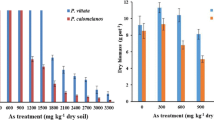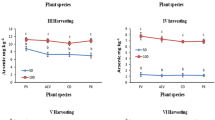Abstract
This study compared the accumulation of arsenic, copper and chromium by Pteris vittata and Pteris umbrosa grown in a glasshouse in soil from a timber treatment facility. Soil was collected from three locations. Accumulation (as percentage removed) varied between these soils but was not related to soil concentration. P. vittata was more efficient than P. umbrosa, both in accumulating As and metals in the below-ground plant parts and in translocating As to the fronds. Under the experimental conditions, only P. vittata could be effectively used in soil from one location for phytoremediation purposes.


Similar content being viewed by others
References
Adriano DC (2001) Trace elements in terrestrial environments, 2nd edn. Springer-Verlag, New York
An Z-Z, Huang Z-C, Lei M, Liao X-Y, Zheng Y-M, Chen T-B (2006) Zinc tolerance and accumulation in Pteris vittata L. and its potential for phytoremediation of Zn- and As-contaminated soil. Chemosphere 62:796–802
Bowles JE (1986) Engineering properties of soils and their measurement, 3rd edn. McGraw-Hill, New York
Cai Y, Georgiadis M, Fourqurean JW (2000) Determination of arsenic in seagrass using inductively coupled plasma mass spectrometry. Spectrochim Acta B 55:1411–1422
EPA (2003) Environmental Compliance Report Wood Preservation Industry Part A. Environmental Protection Agency, Sydney 18 pp
Fayiga AO, Ma LQ (2006) Using phosphate rock to immobilize metals in soil and increase arsenic uptake by hyperaccumulator Pteris vittata. Sci Total Environ 359:17–25
Fayiga AO, Ma LQ, Cao X, Rathinasabapathi B (2004) Effects of heavy metals on growth and arsenic accumulation in the arsenic hyperaccumulator Pteris vittata L. Environ Pollut 132:289–296
Fitz W, Wenzel W, Zhang H, Nurmi J, Stipek K, Fischerova Z, Schweiger P, Kollensperger G, Ma L, Stingeder G (2003) Rhizosphere characteristics of the arsenic hyperaccumulator Pteris vittata L. and monitoring of phytoremoval efficiency. Environ Sci Technol 37:5008–5014
Franchini I, Mutti A (1985) Metabolism and toxicity of chromium compounds. In: Irgolic KJ, Martell AE (eds) Environmental inorganic chemistry. VCH, Deerfield Park, pp 473–485
Gardea-Torresdey JL, Peralta-Videa JR, de la Rosa G, Parsons JG (2005) Phytoremediation of heavy metals and study of the metal coordination by X-ray absorption spectroscopy. Coordin Chem Rev 249:1797–1810
Goh K-H, Lim T-T (2005) Arsenic fractionation in a fine soil fraction and influence of various anions on its mobility in the subsurface environment. Appl Geochem 20:229–239
Hapke H-J (1991) Metal accumulation in the food chain and load of feed and food. In: Merian E (ed) Metals and their compunds in the environment. Occurrence, analysis and biological relevance. VCH, Weinheim, pp 469–479
Harden GJ (1990) Flora of New South Wales, vol 1. New South Wales University Press, Sydney
Koller CE, Patrick JW, Rose RJ, Offler CE, MacFarlane GR (2007) Pteris umbrosa R.Br. as an arsenic hyperaccumulator: Accumulation, partitioning and comparison with the established hyperaccumulator Pteris vittata. Chemosphere 66:1256–1263
Lasat MM (2000) Phytoextraction of metals from contaminated soil: review of plant/soil/metal interaction and assessment of pertinent agronomic issues. J Hazard Subst Res 2:1–25
Liao X-Y, Chen T-B, Lei M, Huang Z-C, Xiao X-Y, An Z-Z (2004) Root distributions and elemental accumulations of Chinese brake (Pteris vittata L.) from As-contaminated soils. Plant Soil 261:109–116
Lombi E, Zhao F-J, Fuhrmann M, Ma LQ, McGrath SP (2002) Arsenic distribution and speciation in the fronds of the hyperaccumulator Pteris vittata. New Phytol 156:195–203
Ma LQ, Komar KM, Kennelley ED (2001a) Methods for removing pollutants from contaminated soil materials with a fern plant. University of Florida, USA
Ma LQ, Komar KM, Tu C, Zhang W, Cai Y, Kennelley ED (2001b) Addendum: a fern that hyperaccumulates arsenic. Nature 411:438
Mandal BK, Suzuki KT (2002) Arsenic around the world: a review. Talanta 58:201–235
Poynton CY, Huang JW, Blaylock M, Kochian LV, Elless MP (2004) Mechanisms of arsenic hyperaccumulation in Pteris species: root As influx and translocation. Planta 219:1080–1088
Rayment GE, Higginson FR (1992) Australian laboratory handbook of soil and water chemical methods, vol 3. Inkata Press, Melbourne
Salt DE, Blaylock M, Kumar PBAN, Dushenko V, Ensley BD, Chet I, Raskin I (1995) Phytoremediation: a novel strategy for the removal of toxic metals from the environment using plants. Bio/Tech 13:468–474
Silva Gonzaga MI, Santos JAG, Ma LQ (2006) Arsenic chemistry in the rhizosphere of Pteris vittata L. and Nephrolepis exaltata L. Environ Pollut 143:254–260
StatSoft I (1995) STATISTICA for Windows. StatSoft, Inc., Tulsa, OK
Tu S, Ma LQ, Luongo T (2004) Root exudates and arsenic accumulation in arsenic hyperaccumulating Pteris vittata and non-hyperaccumulating Nephrolepis exaltata. Plant Soil 258:9–19
Visoottiviseth P, Francesconi K, Sridokchan W (2002) The potential of Thai indigenous plant species for the phytoremediation of arsenic contaminated land. Environ Pollut 118:453–461
Wongkongkatep J, Fukushi K, Parkpian P, DeLaune RD, Jugsujinda A (2003) Arsenic uptake by native fern species in Thailand: effect of chelating agents on hyperaccumulation of arsenic by Pityrogramma calomelanos. J Environ Sci Heal A 38:2773–2784
Zar JH (1999) Biostatistical Analysis. Prentice Hall, New Jersey
Zhang W, Cai Y, Tu C, Ma LQ (2002) Arsenic speciation and distribution in an arsenic hyperaccumulating plant. Sci Total Environ 300:167–177
Zhao FJ, Dunham SJ, McGrath SP (2002) Arsenic hyperaccumulation by different fern species. New Phytol 156:27–31
Acknowledgments
The support of this research by a Collaborative Research Grant from the University of Newcastle and Koppers Australia is gratefully acknowledged. We especially want to thank Paul McEwan and Mark Tildsley for their assistance and interest.
Author information
Authors and Affiliations
Corresponding author
Rights and permissions
About this article
Cite this article
Koller, C.E., Patrick, J.W., Rose, R.J. et al. Arsenic and Heavy Metal Accumulation by Pteris vittata L. and P. umbrosa R. Br.. Bull Environ Contam Toxicol 80, 128–133 (2008). https://doi.org/10.1007/s00128-007-9330-4
Received:
Accepted:
Published:
Issue Date:
DOI: https://doi.org/10.1007/s00128-007-9330-4




